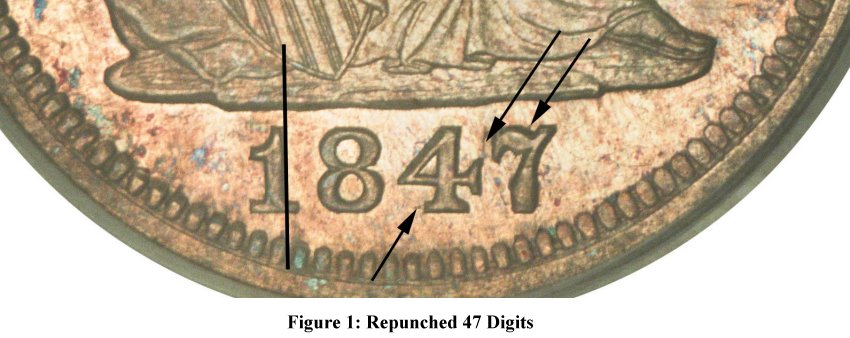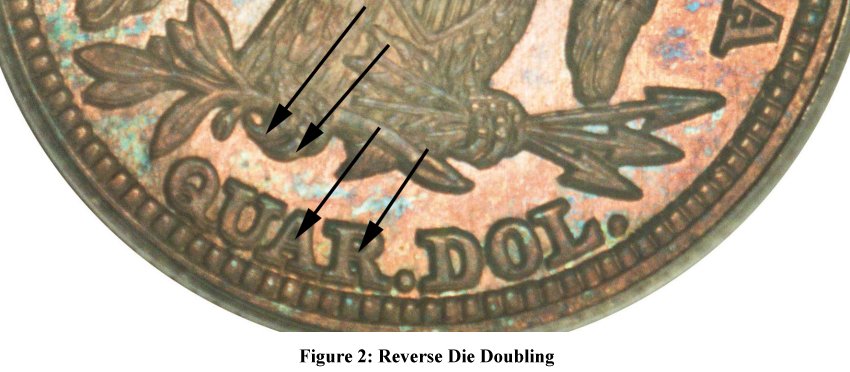

|
|
|
1847 Liberty Seated Quarter Dollar - Repunched Date, Doubled Die Reverse
by Greg Johnson
The 1847 quarter presents the variety collector
with perhaps the most diverse and interesting die marriage set of any Philadelphia
mint seated quarter issue. The eight business strike die pairs listed in Briggs’
“Comprehensive Encyclopedia of United States Liberty Seated Quarters”
(Lima, OH 1991) include a recut date, a doubled die reverse, a compass point
reverse, a misplaced date, a large die chip, a large rim cud, a very high date,
various obvious and distinct die scratches and cracks, and rocks that appear
to have several different shapes. No other issue in the Liberty Seated Quarter
series presents the collector with such an opportunity to include so many interesting
varieties in one set of 8 coins. The single most interesting variety, and one
of only two that currently command a premium, is the doubled die reverse (DDR)
paired with the recut date (1847/47).
Though certainly not common, even by seated quarter standards, the ‘47/47
DDR (Briggs’ 2-A) quarter does appear fairly regularly and in all grades.
I have personally seen two different PCGS MS63 examples, two nice AU’s,
and know of a PCGS MS64 example in an LSCC member’s collection. Despite
this apparent availability, there are few enough of these coins in existence
that even relative rarity can be hard to estimate. It seems like, five years
ago, one could locate a DDR 1847 quarter (Briggs’ 1-A, paired with a normal
date obverse) from time to time, but the ‘47/47 DDR was much more difficult.
More recently, this trend appears to have reversed with most DDR 1847 quarters
offered now having the ‘47/47 obverse. Both of the DDR die pairs appear
to command a premium of around 30 – 50% with high grade examples of the
‘47/47 DDR sometimes being bid up to much higher levels at auction.
Attribution of the two DDR die pairs is fairly straightforward. The reverse
die doubling is very pronounced and obvious even on lower grade coins. Coins
grading as low as VG often still show separation between the crossbars in the
“A” and “R” in “QUAR.” and on the left (facing)
eagle claws. The obverse is equally simple in that the ‘47/47 date position
is unique amongst all of the 1847 obverse dies. The recutting of the date, however,
is worn away quite rapidly and is frequently not visible on examples grading
less than XF.


Figures 1 and 2 show the obverse and reverse dies,
respectively, along with the key attribution points described. Note in Figure
1 that the right side of the “1” lines up with the fourth shield
line, making the date of the 1847/47 obverse the farthest left of all the 1847
obverse dies. Recutting is evident on high-grade specimens near the bottom of
the “4” and at several locations to the left of the seven (two of
which are noted in the figure). Although the entire reverse design appears to
be doubled, Figure 2 indicates the most dramatically doubled areas that tend
to remain fairly obvious even with significant wear.